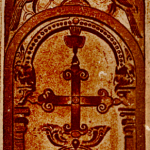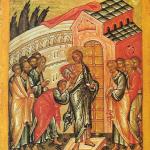 In the Middle Ages, pilgrims who made the arduous trip to Rome to visit St. Peter’s Basilica gazed with fondness and awe upon a larger-than-life bronze statue of St. Peter. The statue, sculpted by Arnolfo di Cambio in the 13th century, depicted the first pope—his right hand extended to confer a blessing, while his left hand clutched the keys of the Kingdom, holding them close to his heart.
In the Middle Ages, pilgrims who made the arduous trip to Rome to visit St. Peter’s Basilica gazed with fondness and awe upon a larger-than-life bronze statue of St. Peter. The statue, sculpted by Arnolfo di Cambio in the 13th century, depicted the first pope—his right hand extended to confer a blessing, while his left hand clutched the keys of the Kingdom, holding them close to his heart.
But for many pilgrims who snaked, single-file, into the great Basilica, it was Peter’s feet that captured their attention. Mounted, as he was, on a tall alabaster pedestal, the feet were at eye-level for travelers; and medieval pilgrims would fervently kiss or at least rub the right foot, which was extended forward from the pedestal—at the same time offering a prayer to St. Peter to be merciful and open the heavenly gates for them, if they should die while on the pilgrimage. So many pilgrims revered the bronze toes, in fact, that the statue has been worn down.

In 1871, St. Peter was given a grand backdrop: A red and gold mosaic, resembling heavy brocade draperies, was mounted behind him. A mosaic medallion of Pope Pius IX, the first pope since Peter to reign for more than 25 years, was installed above his head on the pillar.
 Visitors who are in Rome on June 29, the Solemnity of Sts. Peter and Paul, are treated to another surprise: The statue is vested in an amice, alb, tiara, stole, red cope and a papal ring.
Visitors who are in Rome on June 29, the Solemnity of Sts. Peter and Paul, are treated to another surprise: The statue is vested in an amice, alb, tiara, stole, red cope and a papal ring.















